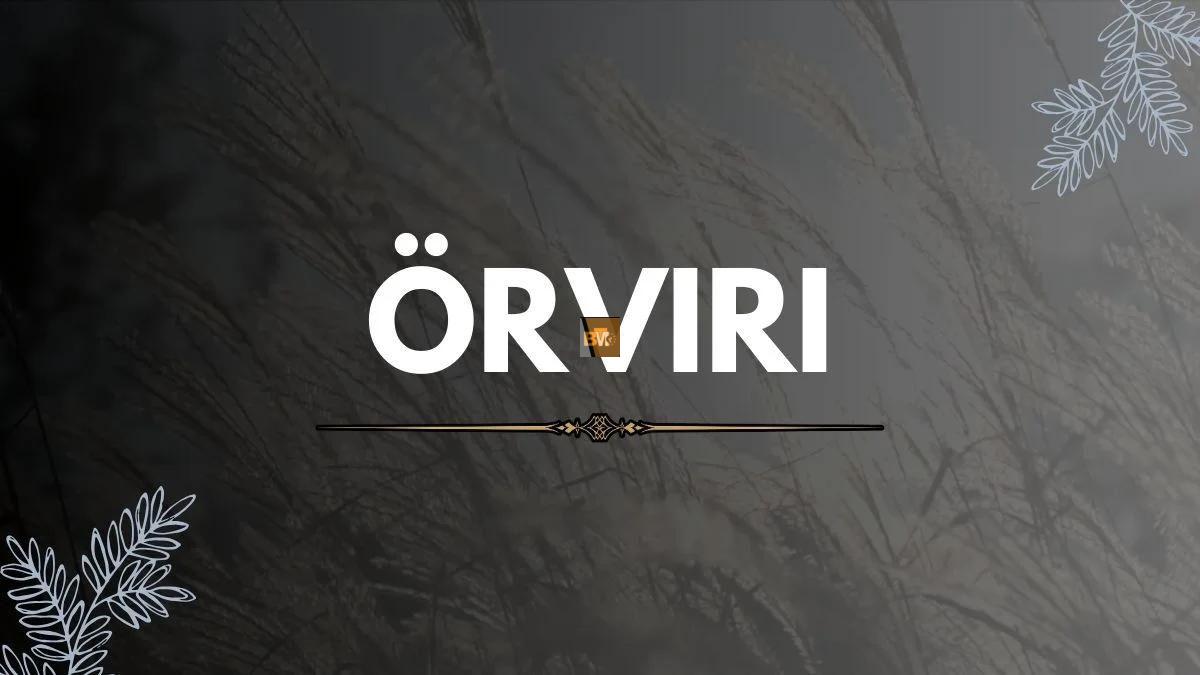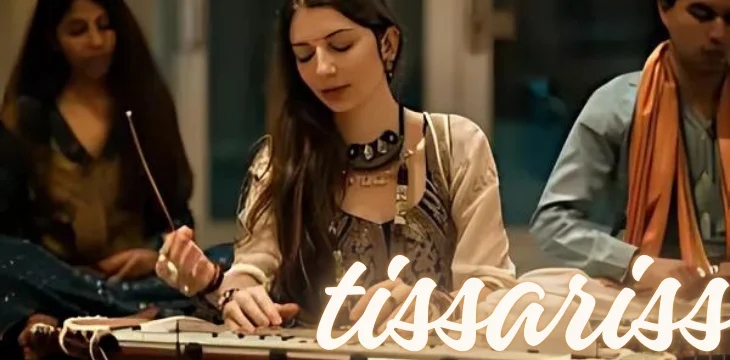Blog
Unveiling the Meaning of Örviri: An In-Depth Exploration

In the ever-evolving landscape of language and culture, Örviri certain words and concepts emerge that seem to carry deep, hidden meanings, often unlocking aspects of identity, history, and collective consciousness. One such term is Örviri, a word that, while obscure, holds significance in certain linguistic and cultural contexts. This article seeks to explore the origins, usage, and potential interpretations of Örviri, shedding light on its nuanced layers.
Origins and Etymology
The word Örviri does not appear prominently in most modern dictionaries or mainstream languages. However, it can be traced to specific linguistic roots in lesser-known dialects and languages, particularly those influenced by the Norse or proto-Indo-European language families. Some scholars believe that the term may have originated from ancient mythological texts or even regional folklore.
The prefix “Ör” is often associated with the concept of “fate” or “destiny” in various Indo-European languages, while “viri” can be linked to the notion of “man” or “strength.” Together, these elements could suggest that Örviri conveys a sense of fate or strength tied to one’s purpose in life or destiny.
In another interpretation, the word could derive from a local dialect, referring to a rare or sacred practice that involved divination, prophecy, or ritualistic activity. The connection to such practices would give Örviri a spiritual or esoteric meaning, related to individuals who perform tasks that are beyond the ordinary realm of human understanding.
Cultural Significance
In some ancient traditions, particularly those of Northern Europe and the British Isles, Örviri might have been used to describe a spiritual or prophetic figure—someone who could “read” or interpret the fates of others. This individual might have been seen as a bridge between the world of humans and the realm of the gods or spirits.
In many ways, this echoes the role of the seer or shaman in various indigenous cultures. These figures were often believed to possess a unique connection to the divine or supernatural realm, offering wisdom that transcended normal human perception. If Örviri has such a connection, it suggests a rich history of belief systems wherein certain individuals were chosen, either by birthright or through some form of divine selection, to understand and alter the course of fate for their communities.
Modern Interpretations
As languages evolve and cultures shift, the meaning of words like Örviri may transform or adapt to modern contexts. Today, there may be more metaphysical or psychological interpretations of the term. Some contemporary thinkers have associated Örviri with concepts like inner strength, spiritual enlightenment, or self-determination. In this interpretation, the term might represent the power of one’s will to shape their own fate, an individual’s capacity to navigate the twists and turns of life with courage and wisdom.
In a more literary sense, Örviri might symbolize an archetypal character—one who is not simply a passive observer of destiny, but an active participant, perhaps even the architect of their own fate. Writers and storytellers might use the word to describe a hero’s journey, wherein the protagonist, much like the ancient seer, faces trials and challenges that will ultimately lead them to discover their true calling.
Örviri in Contemporary Thought
Philosophically, the idea of Örviri could connect to broader discussions about determinism, free will, and the nature of existence. In the context of modern existentialism, the notion of fate and self-determination represented by Örviri invites questions such as: Can we control our destiny, or is it shaped entirely by forces outside our understanding?
Furthermore, in the context of personal growth and self-help movements, Örviri could be viewed as a symbol for anyone striving to break free from the constraints imposed by their past or by societal expectations. The “Örviri” figure in this context would be someone who achieves personal freedom by mastering their own destiny and finding purpose in their life.
The Symbolic Power of Örviri
At its core, the power of Örviri lies in its symbolism. Whether viewed as a historical figure, a metaphysical concept, or a modern archetype, the term encapsulates the human desire to understand and control the forces that shape our lives. It speaks to the notion of fate being neither entirely arbitrary nor completely under our control, but rather a complex interplay of external forces and individual agency.
Moreover, Örviri suggests that each person has an inherent strength—the ability to shape their path, change their story, and uncover deeper truths. This resonates with universal human experiences: seeking purpose, confronting challenges, and ultimately, coming to terms with the forces that govern our existence.
Conclusion
The meaning of Örviri is not singular or static but is layered with cultural, historical, and spiritual significance. It serves as a reminder of the complexities of fate, identity, and personal power. Whether one sees Örviri as a historical figure, a symbol of inner strength, or a modern archetype, the term reminds us of the enduring human quest to understand our place in the world and the power we have to shape our own destinies.
As languages and cultures continue to evolve, Örviri will likely continue to take on new meanings, offering insights into both the past and the present. What is clear, however, is that this word, and the ideas it represents, will continue to resonate with those who seek to understand the delicate balance between fate and free will, strength and vulnerability, past and future.
Blog
Recuperbate The Key to Faster Recovery and Wellness

In today’s fast-paced world,Recuperbate maintaining optimal health and recovering quickly from physical exertion or injury has become increasingly important. Whether you’re an athlete pushing your limits, someone recovering from surgery, or just dealing with everyday stress and fatigue, finding effective ways to promote recovery is vital. One of the most innovative solutions to enhance recovery and wellness is Recuperbate.
What is Recuperbate?
Recuperbate is a health supplement designed to support faster recovery, improve energy levels, and enhance overall wellness. This product is particularly popular among athletes and fitness enthusiasts who seek to recover more effectively after intense physical activity, but it also offers benefits for anyone looking to improve their recovery process, whether from illness, surgery, or simply general wear and tear of daily life.
The core idea behind Recuperbate is to replenish and nourish the body with a blend of natural ingredients that support recovery at the cellular level. By optimizing hydration, promoting muscle repair, and boosting immunity, Recuperbate helps the body bounce back faster and more effectively.
Key Benefits of Recuperbate
- Faster Muscle Recovery
After physical exertion, muscles experience micro-tears that need to heal in order for the body to recover and grow stronger. Recuperbate contains ingredients that support muscle repair, reduce inflammation, and relieve soreness. Key components like amino acids, magnesium, and electrolytes help promote muscle recovery by ensuring proper nutrient delivery to muscles, enabling them to repair and rebuild faster.
- Boosts Hydration and Electrolyte Balance
Proper hydration is essential for recovery, and Recuperbate excels at ensuring the body remains adequately hydrated. Dehydration can delay recovery, impair performance, and increase the risk of injury. Recuperbate contains a precise mix of electrolytes, including potassium, calcium, and sodium, which help the body retain fluid and maintain optimal hydration levels. This electrolyte balance is essential for muscle function, energy levels, and overall wellness.
- Enhances Immune System Function
The body’s immune system can be taxed after physical exertion, stress, or illness. Recuperbate includes ingredients that help support immune health, enabling the body to fight off infections and recover from illness more quickly. Vitamin C, zinc, and other immune-boosting compounds play a key role in reducing recovery time by supporting the body’s natural defenses.
- Promotes Joint Health and Mobility
Recuperbate also features ingredients that promote joint health, such as glucosamine and chondroitin. These compounds support the maintenance of healthy cartilage, which is critical for mobility and reducing joint pain, especially after intense physical activity. With regular use, Recuperbate may help to prevent long-term joint issues, ensuring that you stay active and mobile.
- Improves Sleep and Reduces Fatigue
A good night’s sleep is essential for recovery, and Recuperbate contains ingredients that help promote restful sleep. The formula includes natural compounds like magnesium and adaptogens, which are known for their calming and sleep-enhancing properties. By improving sleep quality, Recuperbate helps the body repair itself more efficiently, leaving you feeling more energized and less fatigued during the day.
- Promotes Overall Wellness
Aside from muscle recovery, joint health, and immune support, Recuperbate is designed to enhance overall wellness. Its blend of vitamins, minerals, and natural compounds works synergistically to ensure that every aspect of your health is supported, from cellular regeneration to stress management. Whether you’re recovering from a workout, surgery, or an illness, Recuperbate offers a comprehensive solution for holistic recovery.
How to Use Recuperbate
For the best results, Recuperbate should be taken according to the instructions on the product label. Typically, it is recommended to consume Recuperbate immediately after physical activity or at the end of a long day. The supplement can be taken as a drink mix or in capsule form, depending on your preference. Incorporating it into your daily routine can help support your body’s natural healing processes and promote a faster, more efficient recovery.
Conclusion
Incorporating a recovery supplement like Recuperbate into your wellness regimen can be a game-changer. Whether you’re recovering from intense physical activity, an injury, or a period of stress, Recuperbate supports faster recovery, enhances energy, and promotes overall health. By optimizing hydration, muscle repair, immune function, and joint health, this powerful formula offers a holistic approach to recovery. For anyone seeking to perform at their best and recover quickly, Recuperbate is truly the key to a faster, more effective path to wellness.
Blog
The Art of Tissariss: Crafting Beauty and Tradition

Tissariss is more than just an artistic practice—it’s a symbol of cultural heritage, creativity, and craftsmanship. Rooted in centuries-old traditions, this intricate form of art has evolved through time, embracing modern aesthetics while preserving its core values. Whether you’re an art enthusiast, a collector, or simply curious about global artistic expressions, Tissariss offers a fascinating insight into how beauty and tradition merge. In this article, we’ll dive deep into the origins, evolution, and contemporary relevance of Tissariss, as well as its influence on modern art forms.
The History of Tissariss
Tissariss is believed to have originated in the ancient regions of Central Asia and the Middle East, where artisans used natural dyes, handwoven fabrics, and meticulous patterns to create stunning works of art. Its early iterations were often influenced by religious and ceremonial customs, with each piece telling a unique story. Over time, the craft of Tissariss expanded beyond borders, influenced by cross-cultural exchanges, becoming a beloved tradition in many cultures around the world.
As trade routes opened, Tissariss found its way to Europe, Asia, and beyond, where it was embraced by different societies, each adding its own touch. The art form flourished, being passed down through generations, with new techniques and styles evolving. From intricate tapestries to decorative garments, Tissariss represented not only an aesthetic pursuit but also a reflection of the cultural and spiritual beliefs of the people who practiced it.
Cultural Significance and Traditions
Tissariss holds immense cultural significance, especially in regions where it originated. It often symbolized social status, religious beliefs, and a connection to the earth. In some cultures, Tissariss textiles were used in religious ceremonies, weddings, and other important life events. The colors and patterns held deep meanings, with each hue and motif chosen to convey specific messages, such as prosperity, fertility, or protection.
For example, red might symbolize strength and courage, while blue represented wisdom and spiritual growth. The craftsmanship itself was seen as a form of meditation, with artisans dedicating countless hours to perfecting their work. Tissariss wasn’t just about the final product but the process—how it brought communities together and allowed individuals to express their identity through art.
Key Techniques in Tissariss Crafting
Tissariss is characterized by its elaborate techniques, which require a high level of skill and patience. The main processes involve weaving, dyeing, and embroidery, each of which contributes to the art form’s distinctive look. Traditional handloom weaving is a cornerstone of Tissariss, producing the signature intricate patterns that define this craft.
The dyeing process is equally important, with natural dyes sourced from plants, minerals, and even insects to create vibrant, long-lasting colors. Artisans also utilize resist-dye techniques, which help create complex designs by preventing certain areas of the fabric from absorbing dye. Additionally, embroidery techniques add further embellishments, often using gold or silver threads to elevate the visual appeal of the piece.
The Materials Used in Tissariss Art
Tissariss is known for its use of high-quality, natural materials. Silk, wool, and cotton are the most commonly used fabrics, with silk being favored for its luxurious feel and sheen. The quality of the fabric plays a crucial role in the final appearance and durability of the piece. Artisans also incorporate metallic threads, beads, and other embellishments to enhance the design’s richness.
Natural dyes, made from sources like indigo, saffron, and madder, are carefully applied to create the stunning color palettes that Tissariss is known for. The materials chosen not only reflect the aesthetic preferences of the region but also the environment, with many of the dyes and fabrics sourced locally.
Modern-Day Adaptations of Tissariss
While Tissariss has its roots in tradition, it has also adapted to modern tastes and trends. Contemporary artisans are experimenting with new materials, techniques, and color palettes, while still honoring the craft’s origins. This blend of old and new has made Tissariss increasingly popular in global markets, where it is appreciated for its beauty and cultural significance.
Fashion designers have also embraced Tissariss, incorporating its intricate patterns and bold colors into modern clothing lines. From haute couture to everyday wear, Tissariss textiles are being reimagined in ways that make them accessible to new audiences, while still maintaining their artistic integrity.
Tissariss in Contemporary Art and Fashion
The influence of Tissariss extends beyond traditional textile art into the realms of contemporary art and fashion. Designers and artists around the world have been inspired by the patterns, techniques, and cultural narratives of Tissariss, creating a resurgence in its popularity. This has led to collaborations with global fashion houses, art exhibitions, and even modern home décor trends, where Tissariss-inspired pieces bring a touch of cultural heritage into everyday life.
Famous Tissariss Artworks and Artists
Several renowned artists and craftspeople have left their mark on the world of Tissariss. Their works are celebrated not only for their technical excellence but also for their ability to capture the essence of the cultures from which they hail. These pieces are often showcased in museums and galleries, allowing a wider audience to appreciate the mastery behind the craft.
How to Appreciate Tissariss Art
Understanding Tissariss requires an appreciation for the detail, effort, and symbolism that goes into each piece. When viewing Tissariss art, pay close attention to the patterns, colors, and textures, as each element carries a deeper meaning. Look beyond the surface and explore the cultural stories embedded in the fabric. Visiting exhibitions, learning from artisans, and even trying your hand at some of the techniques can deepen your appreciation for this timeless art form.
Starting Your Own Tissariss Collection
For those interested in collecting Tissariss, it’s important to understand the origins and authenticity of each piece. Look for reputable sellers or galleries that specialize in traditional and contemporary Tissariss textiles. Start small, perhaps with a single piece, and gradually expand your collection as you learn more about the craft. Be sure to consider the quality of the materials, the intricacy of the design, and the cultural significance of the artwork.
The Future of Tissariss: Trends and Innovations
As the world becomes more connected, Tissariss continues to evolve. With the rise of sustainable and ethical fashion, artisans are turning to eco-friendly practices, using organic materials and natural dyes. Additionally, digital technologies are being introduced to preserve traditional patterns while experimenting with new designs. This fusion of the past and future ensures that Tissariss will remain relevant for generations to come.
FAQs
- What is Tissariss? Tissariss is an ancient form of textile art known for its intricate designs and cultural significance, blending traditional craftsmanship with modern aesthetics.
- Where did Tissariss originate? Tissariss originated in Central Asia and the Middle East and has evolved over time, influencing various cultures around the world.
- What materials are used in Tissariss? The most common materials used in Tissariss are silk, wool, cotton, and natural dyes sourced from plants and minerals.
- How is Tissariss made? Tissariss is crafted through a combination of weaving, dyeing, and embroidery, often utilizing handloom techniques and natural dye processes.
- What is the cultural significance of Tissariss? Tissariss holds deep cultural meaning, often symbolizing social status, religious beliefs, and the connection to nature and spirituality.
- How has Tissariss influenced modern art? Tissariss has inspired contemporary artists and fashion designers, leading to its incorporation into global fashion trends and modern home décor.
- Can I start a Tissariss collection? Yes, you can start a Tissariss collection by purchasing pieces from reputable galleries or artisans, focusing on quality and authenticity.
- Why is Tissariss important today? Tissariss continues to thrive as a symbol of cultural heritage and sustainability, with modern adaptations ensuring its relevance in today’s world.
- Is Tissariss eco-friendly? Many modern Tissariss artisans use sustainable materials and practices, making it an eco-friendly art form.
- What is the future of Tissariss? The future of Tissariss lies in its ability to blend tradition with innovation
Conclusion
Tissariss is more than just an art form—it is a living tradition that continues to captivate and inspire. With its intricate designs, meaningful patterns, and cultural significance, Tissariss bridges the gap between the past and the present. As artisans innovate and adapt, Tissariss remains a symbol of beauty, history, and sustainability. The future of Tissariss is bright, as its legacy is carried forward through both traditional craftsmanship and modern interpretations. Whether you are a collector, a creator, or an admirer, Tissariss offers a rich and rewarding journey into the world of art and culture.
Blog
Waethicc: Unveiling the Popular Trend in Digital Spaces

In the fast-evolving world of digital media and online culture, Waethicc new terms, slang, and trends regularly emerge, capturing the attention of internet users worldwide. One such term that has recently gained traction is “Waethicc.” While it may seem mysterious to some, this term holds significant relevance in niche communities, particularly those related to internet culture, art, and memes. This article explores what Waethicc means, its origins, and how it has gained popularity in online spaces.
What is Waethicc?
The term “Waethicc” is a combination of two elements: “Wae” and “Thicc.” Each of these parts has its roots in internet culture.
- Wae: Derived from the Ugandan Knuckles meme, “Wae” refers to a simplified pronunciation of “way” popularized by the phrase “Do you know de wae?” The Ugandan Knuckles meme became a viral internet sensation in 2018, originating from a video game modification in VRChat. The phrase and the comical depiction of the Knuckles character contributed to its widespread use in online forums.
- Thicc: The term “thicc” is a playful slang word that has been widely used online to describe someone or something that is voluptuous, curvaceous, or attractively full-figured. The term gained traction within meme culture to emphasize exaggerated body proportions, often in a humorous or stylized manner.
When combined, “Waethicc” merges these two memes, resulting in a fun, quirky phrase that plays on both the humor of internet slang and the exaggeration of body shapes commonly seen in fan art and online animations.
The Popularity of Waethicc in Digital Communities
The rise of Waethicc is closely linked to digital art and meme culture. Artists often use this concept to create exaggerated, cartoonish versions of characters, typically with humorous proportions. Social media platforms like Twitter, Instagram, and Reddit have become breeding grounds for sharing and amplifying this trend. Fan art communities, in particular, have embraced Waethicc, creating artwork that parodies popular characters by giving them “thicc” body shapes in a nod to the humorous origins of the term.
Another factor in the growing popularity of Waethicc is its memeability. The internet loves to remix and recontextualize existing jokes, and Waethicc provides the perfect mix of familiar elements (memes and exaggerated proportions) to allow creative expression. From animated gifs to satirical artwork, the Waethicc trend has spread across various forms of digital content, often accompanied by lighthearted commentary.
Waethicc in Pop Culture and Media
As with many internet phenomena, Waethicc has transcended the realm of memes and found its way into pop culture. While not as mainstream as other internet trends, its influence can be seen in fan-driven content across multiple media forms. Whether it’s videos, digital illustrations, or meme compilations, Waethicc has carved out its own niche in the larger landscape of online creativity.
Why Waethicc Resonates with Audiences
Waethicc’s success is largely driven by its humor, relatability, and connection to beloved characters from games, cartoons, and pop culture. It also provides a space for fans to poke fun at the often-over-the-top representations of characters in fan art. In a way, Waethicc is a critique of the way certain media exaggerates physical attributes, wrapped up in a humorous, self-aware package.
Additionally, the internet thrives on niche humor and insider jokes. Waethicc is a prime example of how certain terms and ideas can quickly become part of the larger digital lexicon, allowing fans and creators to bond over shared references and cultural touchstones.
Conclusion
Waethicc is a quirky, humorous trend that highlights the playful nature of internet culture. By blending elements from popular memes like “Wae” and “Thicc,” it offers a creative way for artists and meme enthusiasts to explore exaggerated character designs and humor. While Waethicc may not be a household term, it holds a special place in the hearts of many internet users who enjoy the lighthearted, creative side of digital media.
As internet culture continues to evolve, trends like Waethicc serve as a reminder of the dynamic and ever-changing nature of online communities, where humor, art, and creativity come together to create something unique and entertaining.
-

 Fashion8 years ago
Fashion8 years agoThese ’90s fashion trends are making a comeback in 2017
-

 Entertainment8 years ago
Entertainment8 years agoThe final 6 ‘Game of Thrones’ episodes might feel like a full season
-

 Fashion8 years ago
Fashion8 years agoAccording to Dior Couture, this taboo fashion accessory is back
-

 Entertainment8 years ago
Entertainment8 years agoThe old and New Edition cast comes together to perform
-

 Sports8 years ago
Sports8 years agoPhillies’ Aaron Altherr makes mind-boggling barehanded play
-

 Business8 years ago
Business8 years agoUber and Lyft are finally available in all of New York State
-

 Games10 months ago
Games10 months agoEnhancing Your FPS Gaming Experience with HACK마트: Tips and Benefits
-

 Entertainment8 years ago
Entertainment8 years agoDisney’s live-action Aladdin finally finds its stars




